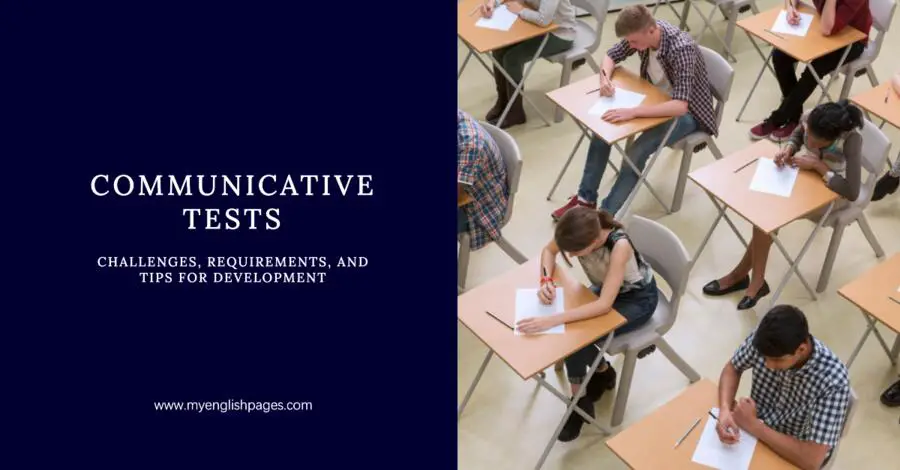Table of Contents
Introduction
Communicative language teaching (CLT) emphasizes the importance of meaningful interaction and real-world communication in language learning. If teaching follows the communicative approach, it is essential that assessments align with this methodology.
However, many teachers find developing communicative tests to be a challenging task.
This blog post explores the difficulties associated with creating communicative tests, outlines the key requirements for effective testing, and provides practical tips and examples to help educators design communicative assessments.
Difficulties in Developing Communative Tests

Designing communicative tests is not without its challenges. These difficulties stem from both theoretical and practical considerations, particularly in English as a Foreign Language (EFL) contexts. Below are some of the most significant challenges teachers face:
- Developing Effective Assessment Instruments
Creating assessment tools that accurately and efficiently measure communicative competence in diverse classroom settings is a complex task. Teachers must ensure that the tests reflect real-world language use while remaining feasible to administer and score. - Aligning Theory and Practice
Communicative tests must balance the theoretical principles of communicative language teaching with the practical requirements of test design. This includes integrating communicative goals—such as meaningful interaction and authentic language use—with established testing principles like validity, reliability, and practicality. - Constraints of EFL Contexts
Communicative theory emphasizes the use of authentic materials and realistic social situations. However, in EFL settings, learners often lack opportunities to practice English outside the classroom. This makes it difficult to replicate real-world communication scenarios, which are essential for effective communicative testing. - Subjectivity in Scoring
Unlike traditional tests, which often have clear right or wrong answers, communicative tests assess how well learners use language in context. This can lead to subjective scoring, as responses may vary widely and require raters to evaluate appropriateness, politeness, and cultural relevance. - Integrating Multidimensional Competence
Communicative competence encompasses not only grammatical accuracy but also sociolinguistic, pragmatic, and strategic skills. Designing tests that capture this multidimensional nature of language use is a significant challenge.
Key Requirements for Communicative Tests

Before developing any test, it is crucial to consider the foundational requirements of validity, reliability, and practicality. These principles ensure that the test is effective, fair, and feasible.
- Validity
Validity refers to the extent to which a test measures what it is intended to measure. It includes:- Content Validity: Does the test cover the specified learning objectives?
- Construct Validity: Does the test reflect the theoretical principles of communicative competence?
- Face Validity: Does the test appear to measure what it claims to measure?
- Reliability
Reliability ensures that the test produces consistent results. It includes:- Test Reliability: Would the same test yield similar results if administered to the same or similar groups on different occasions?
- Inter-rater Reliability: Do different raters agree on the scoring of the same performance?
- Intra-rater Reliability: Does the same rater score a performance consistently over time?
- Practicality
A test must be practical in terms of cost, time, ease of administration, and scoring. Teachers must consider whether the test can be implemented within the constraints of their specific teaching context.
Tips for Developing Communicative Tests
To create effective communicative tests, teachers should focus on assessing appropriateness and relevance rather than mere grammatical accuracy. Below are some practical tips:
- Base Tests on a Theoretical Framework
Start with a clear understanding of the principles of communicative language teaching and testing. This provides a solid foundation for test design. - Use Engaging and Relevant Content
Incorporate interesting and motivating content that reflects real-life situations. This could include role-plays, simulations, or problem-solving tasks that require interaction. - Bias for the Best
Design tests that encourage learners to perform at their best. This can be achieved by creating a stress-free environment, providing clear instructions, and allowing sufficient time to complete tasks. - Promote Washback
Use tests as a tool for learning and improvement. Provide feedback that helps learners identify their strengths and areas for development. - Consider Context-Specific Needs
Tailor tests to the specific needs of the learners. For example, a test for business English learners might focus on negotiating or writing emails, while a test for university students might emphasize academic writing or presentations. - Assess Multidimensional Competence
Ensure that tests evaluate not only linguistic accuracy but also sociolinguistic, pragmatic, and strategic skills. This reflects the complexity of real-world communication.
Examples of Communicative Tests
Here are some examples of communicative test tasks that align with the principles outlined above:
- Information Gap Activities
In this task, two or more learners are given different pieces of information. They must communicate effectively to complete the task, such as filling in a missing schedule or solving a problem. This tests their ability to negotiate meaning and use language interactively. - Letter Writing
Learners might be asked to write a formal letter, such as a business inquiry or a response to a customer complaint. This assesses their ability to use appropriate tone, register, and structure in written communication. - Note-Taking and Summarizing
Testees listen to a lecture or conversation and take notes. They then use their notes to write a summary or report. This evaluates their listening comprehension, note-taking skills, and ability to synthesize information. - Role-Plays
Learners participate in simulated real-life scenarios, such as making a reservation, conducting a job interview, or resolving a conflict. This tests their ability to use language appropriately in social and professional contexts. - Group Discussions
Learners engage in a group discussion on a relevant topic, such as environmental issues or workplace challenges. This assesses their ability to express opinions, negotiate, and collaborate effectively.
Conclusion
Developing communicative tests is undoubtedly challenging, but it is also a rewarding endeavor. By focusing on meaningful communication, aligning tests with theoretical principles, and considering the specific needs of learners, teachers can create assessments that truly reflect the goals of communicative language teaching.
Communicative tests provide valuable opportunities for learners to demonstrate their language skills in authentic and relevant ways, whether through information gap activities, role-plays, or writing tasks.
Related Pages
- Definition of testing, assessment, and evaluation
- Assessment Terminology: A Glossary of The Most Common Terms
- The Communicative Language Teaching: A Guide to The Communicative Approach
- Task-Based Language Teaching (TBLT)
References
- Swain, M. (1984). Large-scale communicative language testing: A case study.
- Bachman, L. F., & Palmer, A. S. (1996). Language testing in practice. Oxford University Press.

